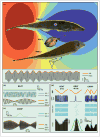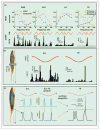Efficient computation via sparse coding in electrosensory neural networks
- PMID: 21683574
- PMCID: PMC4529320
- DOI: 10.1016/j.conb.2011.05.016
Efficient computation via sparse coding in electrosensory neural networks
Abstract
The electric sense combines spatial aspects of vision and touch with temporal features of audition. Its accessible neural architecture shares similarities with mammalian sensory systems and allows for recordings from successive brain areas to test hypotheses about neural coding. Further, electrosensory stimuli encountered during prey capture, navigation, and communication, can be readily synthesized in the laboratory. These features enable analyses of the neural circuitry that reveal general principles of encoding and decoding, such as segregation of information into separate streams and neural response sparsification. A systems level understanding arises via linkage between cellular differentiation and network architecture, revealed by in vitro and in vivo analyses, while computational modeling reveals how single cell dynamics and connectivity shape the sparsification process.
Copyright © 2011 Elsevier Ltd. All rights reserved.
Figures



Similar articles
-
Sparse and dense coding of natural stimuli by distinct midbrain neuron subpopulations in weakly electric fish.J Neurophysiol. 2011 Dec;106(6):3102-18. doi: 10.1152/jn.00588.2011. Epub 2011 Sep 21. J Neurophysiol. 2011. PMID: 21940609 Free PMC article.
-
Parallel sparse and dense information coding streams in the electrosensory midbrain.Neurosci Lett. 2015 Oct 21;607:1-6. doi: 10.1016/j.neulet.2015.09.014. Epub 2015 Sep 12. Neurosci Lett. 2015. PMID: 26375927 Free PMC article.
-
Variable synaptic strengths controls the firing rate distribution in feedforward neural networks.J Comput Neurosci. 2018 Feb;44(1):75-95. doi: 10.1007/s10827-017-0670-8. Epub 2017 Nov 10. J Comput Neurosci. 2018. PMID: 29124504
-
Neural strategies for optimal processing of sensory signals.Prog Brain Res. 2007;165:135-54. doi: 10.1016/S0079-6123(06)65009-7. Prog Brain Res. 2007. PMID: 17925244 Review.
-
Phantoms in the brain: ambiguous representations of stimulus amplitude and timing in weakly electric fish.J Physiol Paris. 2008 Jul-Nov;102(4-6):209-22. doi: 10.1016/j.jphysparis.2008.10.010. Epub 2008 Nov 1. J Physiol Paris. 2008. PMID: 18984041 Free PMC article. Review.
Cited by
-
Serotonin Selectively Increases Detectability of Motion Stimuli in the Electrosensory System.eNeuro. 2018 May 25;5(3):ENEURO.0013-18.2018. doi: 10.1523/ENEURO.0013-18.2018. eCollection 2018 May-Jun. eNeuro. 2018. PMID: 29845105 Free PMC article.
-
How auditory selectivity for sound timing arises: The diverse roles of GABAergic inhibition in shaping the excitation to interval-selective midbrain neurons.Prog Neurobiol. 2021 Apr;199:101962. doi: 10.1016/j.pneurobio.2020.101962. Epub 2020 Nov 23. Prog Neurobiol. 2021. PMID: 33242571 Free PMC article.
-
Bursts and isolated spikes code for opposite movement directions in midbrain electrosensory neurons.PLoS One. 2012;7(6):e40339. doi: 10.1371/journal.pone.0040339. Epub 2012 Jun 29. PLoS One. 2012. PMID: 22768279 Free PMC article.
-
Roles for Coincidence Detection in Coding Amplitude-Modulated Sounds.PLoS Comput Biol. 2016 Jun 20;12(6):e1004997. doi: 10.1371/journal.pcbi.1004997. eCollection 2016 Jun. PLoS Comput Biol. 2016. PMID: 27322612 Free PMC article.
-
Serotonin selectively enhances perception and sensory neural responses to stimuli generated by same-sex conspecifics.Proc Natl Acad Sci U S A. 2013 Nov 26;110(48):19609-14. doi: 10.1073/pnas.1314008110. Epub 2013 Nov 11. Proc Natl Acad Sci U S A. 2013. PMID: 24218585 Free PMC article.
References
-
- Barlow HB. Single Units and sensation: a neuron doctrine for perceptual psychology. Perception. 1972;1:371–394. - PubMed
-
- Rolls ET, Tovee MJ. Sparseness of the neuronal representation of stimuli in the primate temporal visual cortex. J Neurophysiol. 1995;73:713–726. - PubMed
-
- Quiroga RQ, Reddy L, Kreiman G, Koch C, Fried I. Invariant visual representation by single neurons in the human brain [see comment] Nature. 2005;435:1102–1107. - PubMed
-
- Perez-Orive J, Mazor O, Turner GC, Cassenaer S, Wilson RI, Laurent G. Oscillations and sparsening of odor representations in the mushroom body. Science. 2002;297:359–365. - PubMed
-
- Olshausen BA, Field DJ. Sparse coding of sensory inputs. Curr Opin Neurobiol. 2004;14:481–487. - PubMed
Publication types
MeSH terms
Grants and funding
LinkOut - more resources
Full Text Sources

